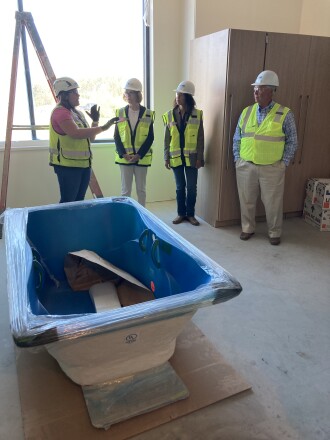WADENA, Minn. — The things that can be accomplished with $72 million are impressive.
Look no further than the rural health care center of the future, Tri-County Health Care’s new health center just west of Wadena. Miles of wiring, conduit, gas and oxygen lines. Tons of sheetrock, steel beams and windows that reach to the sky.
ADVERTISEMENT
The brunt of the cost of this nearly 126,000 square foot facility is covered by a $42 million direct loan from the USDA Rural Development Community Facilities program. USDA representatives, including USDA Rural Development Under Secretary Xochitl Torres Small, and U.S. Sen. Tina Smith, D-Minn., were pleased to see those dollars at work on a visit to the site on Tuesday, Aug. 23. This new facility is just four months away from completion. Mortenson Construction project manager Jessica Deitner said the anticipated completion date is Dec. 16.
Fresh paint was on one of the walls of the new patient rooms; other areas were taped off for flooring to be installed; and pavement is expected to be poured this week. The inside of the facility has taken shape to allow for a better understanding of just how things will actually look.

While the funds are being used to build this new facility, it is what the staff plan to do with this place that had the attention of the senator and USDA staff, which included
The group wound their way through the facility and at one point snaked into a birthing suite. They surrounded a huge tub that would soon be installed in the bathroom.
TCHC Chief Medical Officer Bobbi Adams shared that while Tri-County Health Care has seen fewer babies born at the facility in recent years, a partial impact from COVID-19, they hope to increase the number of births from around 150 this year, to 250 annually in the coming years.

Smith said she was was keenly interested in the ways in which rural health care could help reduce high maternal mortality rates in rural areas. Smith is a member of the Senate Health Committee, chairs the Subcommittee on Rural Development and the Senate Rural Health Caucus. Earlier this year, her bill to address America’s high maternal mortality rate in rural areas, the Rural Maternal and Obstetric Modernization of Services (MOMS) Act was signed into law.
Tri-County Health Care, which is becoming Astera Health, has an opportunity to assist an issue that most of the more urban parts of the country would never deal with. In the counties of Wadena, Todd and Otter Tail, that issue is providing assistance to the Amish community.
“The Amish are relatively under served,” Adams said. The primary midwife in the area for the Amish died in a car crash, Adams shared. “So Tri-County reached out to them to really open our doors.”
ADVERTISEMENT
Adams shared that the staff, including midwife Dawn Dahlgren-Roemmich, have been trying to provide outreach to the Amish community so that they can know the warning signs of a problem in a pregnancy and hopefully get the mother and child help needed at the hospital prior to giving birth at home. While they may not have these families adding to the number of births at the new hospital, the outreach intends to help save lives.
“It’s worked well,” Adams said. “We’ve had a recent number of them coming in for that, so that’s pretty rewarding to see. We’re really trying to reduce the emergency component.”
Smith was pleased to hear of the prenatal care that was a focus of this facility in working to reduce infant mortality.
“What they are doing with this hospital with huge help from the USDA is being able to create a facility that is really worthy of the need in this part of the state,” Sen. Smith said following the tour.
“It really shows that when you invest in local leadership, you invest in thriving rural communities,” Torres Small said. “So Rural Development is proud of this $42 million loan that’s going to support this project.”
The new facility also provides increased technology for better air quality. The extensive use of windows is meant to provide a more healing, relaxing environment. The focus on less in-patient and more outpatient follows the trends of improved procedures.
“It was great to have Under Secretary Torres Small here to see a glimpse of what rural Minnesota has to offer," Smith said. "Increasing health care delivery in rural areas is important for building prosperous and resilient rural communities."
ADVERTISEMENT
At the conclusion of the tour Tri-County Health Care president and CEO Joel Beiswenger took a moment to bend the ear of the visitors regarding his experiences with applying for financing. He said the Community Facilities program was one such application that he was told was difficult to complete. He said it was an extensive process, but that it was worth it.
“It’s the best deal, the cheapest money, the longest term,” Beiswenger said. The roughly $42 million loan will be paid over 35 years with an interest rate under 3%. There wasn’t a better offer on the table. He suggested perhaps there may be ways to make it more user friendly.
Beiswenger suggested that what would make this program even better is if they could work with the local banks to pool the money.
“That’s rural development in my mind,” Beiswenger said.













